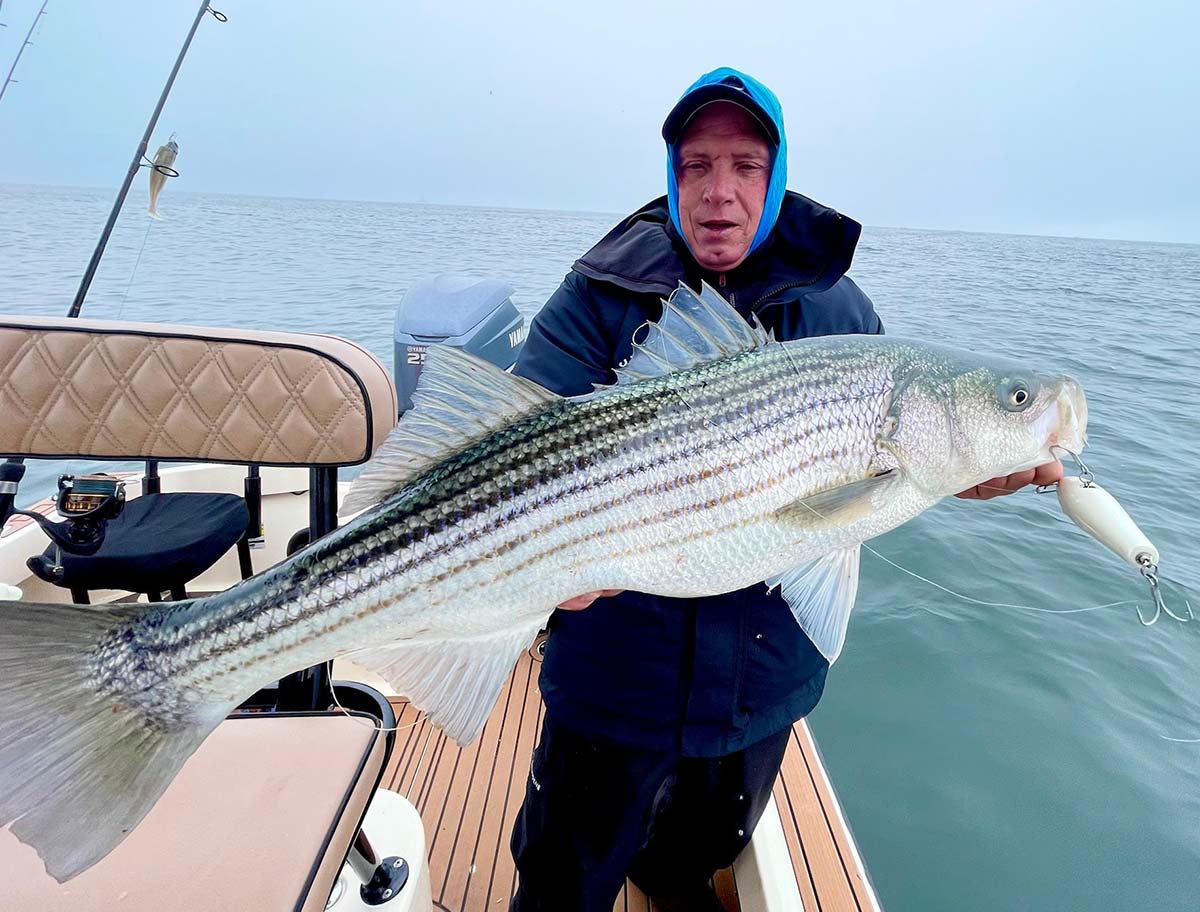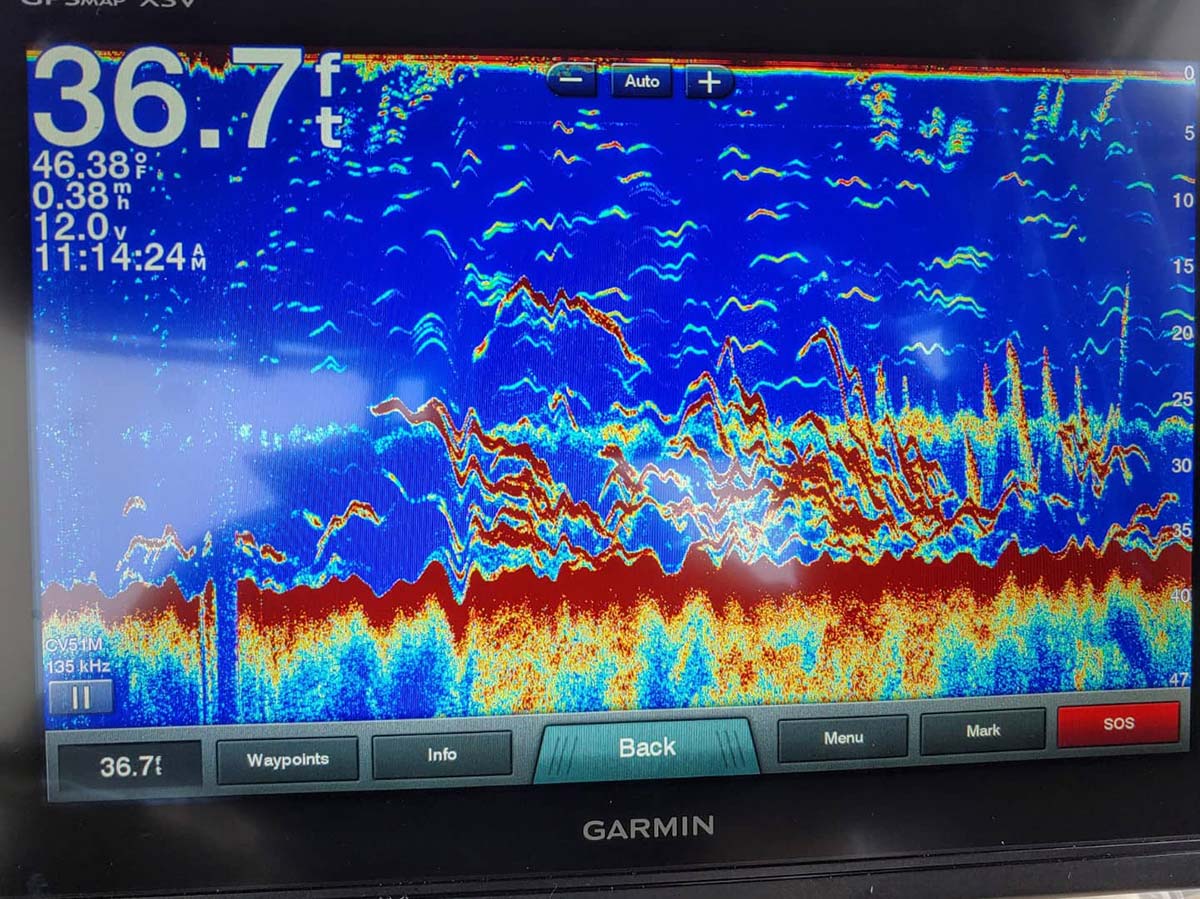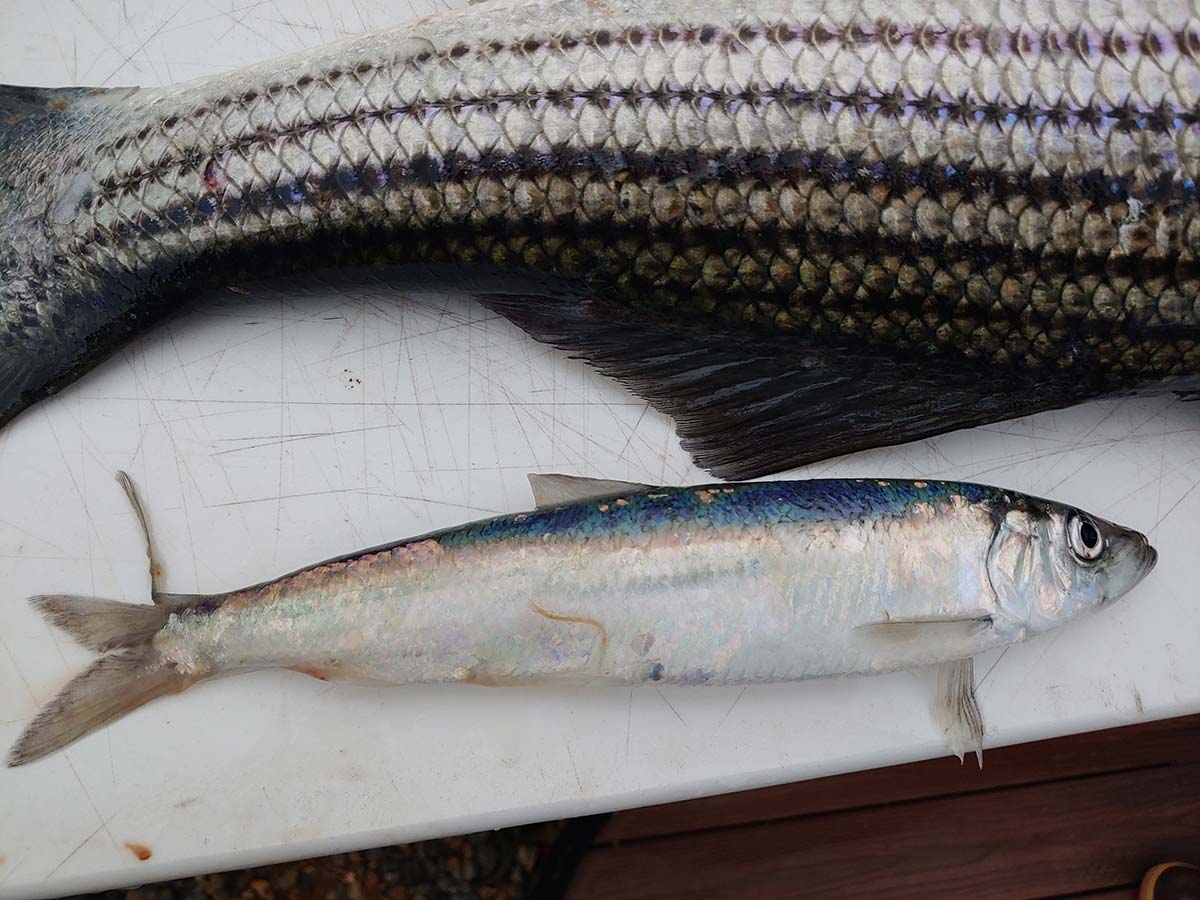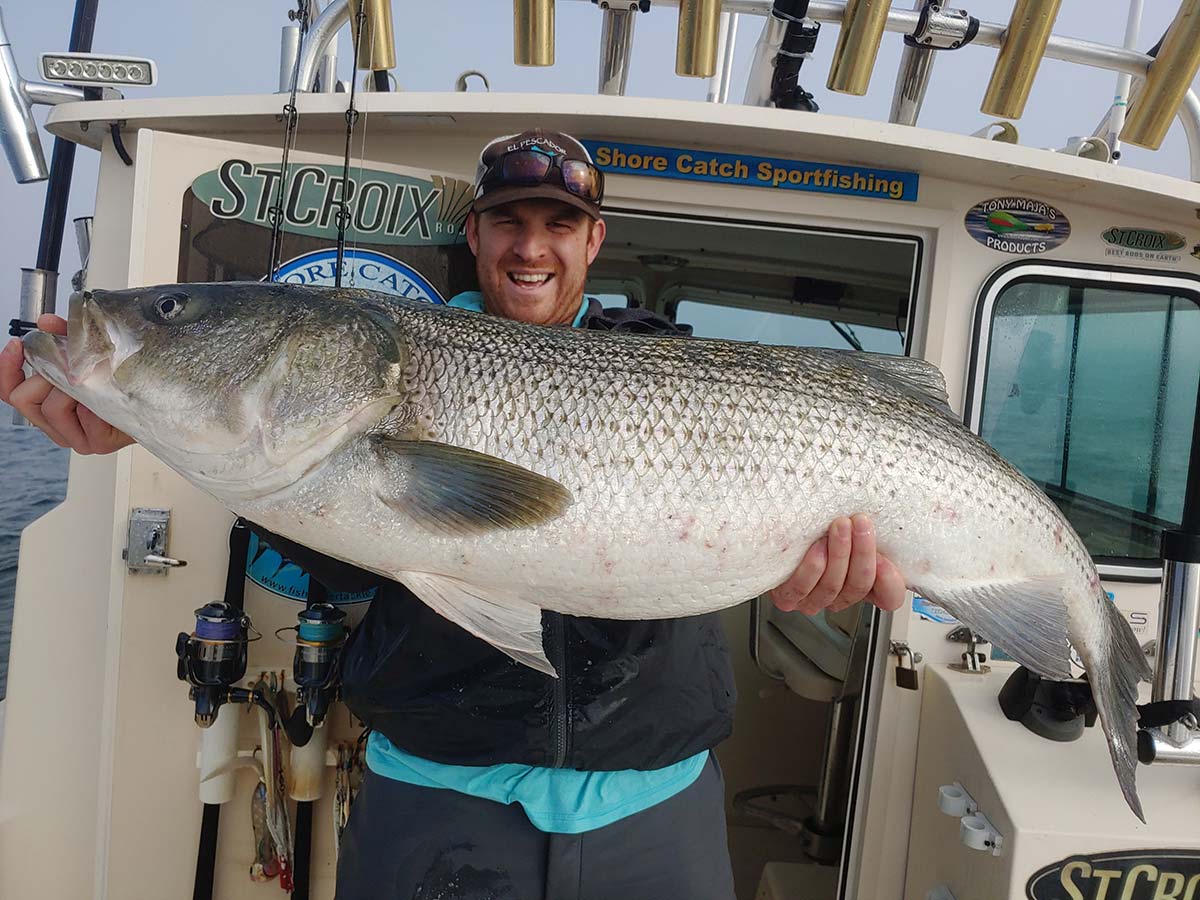
Make it a December to remember with jumbo holiday stripers.
One of the things I love about living along the Jersey Shore is that we have a trophy striped bass fishery that lasts all season long, and December is no exception.
While many by now may have put their boats and surf tackle away and have holiday shopping on their minds, my mind is still thinking trophy bass. Big striped bass will present themselves this month along our coast as we see migratory bass dropping down from New England on their way to their wintering grounds. What stops them and holds them in our area is a tolerable water temperature and the presence of bait.
Looking back and checking my temperature logs for the month of December out of the Manasquan area we usually see ocean temperatures drop from 50 degrees at the beginning of December to 45 degrees by the end of the month during a mild winter. However, if we have any icy cold fronts with below freezing temperatures dropping down out of Canada that last a week or more ocean temperatures can plummet quickly into the lower 40-degree ranges and our December run of big bass will end quickly.
Holiday Herring
Dropping water temperatures coincide with the movement of a big bait that holds the big stripers. This would be the sea herring that moves in from offshore to within the three-mile-line. These herring are different from their anadromous spring cousins – the alewife and bluebacks – but are Atlantic herring that many anglers will jig in our inlets with sabiki rigs and then pickle, can, and eat. The December run of big striped bass is dependent on this forage and the location of these baits will determine the route that the fish will take. If the sea herring remain offshore beyond the three-mile-line then the bass will too and our season will end with just much smaller fish. But if the bulk of the sea herring move inshore within 3 miles than it can truly be a December to remember.
This is exactly what happened last season as we had a very mild December when it came to air temperatures. The Rutgers New Jersey Weather Network reported “The statewide average December temperature of 41.5 degrees was the third warmest on record, 4.9 degrees above the 1991–2020 normal, and a much larger 7.8 degrees margin above the 1895–present normal.” Since air temperatures were relatively warm ocean temperatures dropped very slowly.
On December 31, 2021 we had ocean temperatures of 45 degrees and an epic run of sea herring along the beach. I was out that day for my last trip with fellow captain and friend Dave Shunke and his kids and the sights and sounds of gulls and gannets dive bombing the baits along with bass tall whacking them out of the water was a great and memorable way to end my season. Every cast produced a nice fish. Any boater or surfcaster that was out also shared in the same experience.
Typically, the first three weeks of December is usually when this run of sea herring and big bass materializes. When the sea herring run begins word will spread quickly throughout the fishing community that they have arrived and big bass are being caught. Tackle shops will get reports, and Facebook, Twitter, and Instagram will light up with photos and the news. Bass can range in size from just over 28 inches into the mid-30-pound range. Both big and small sizes will be mixed.

Catch, Photo & Release
With the tremendous run of 40- to 50-inch bass that we have seen in October and November it wouldn’t surprise me if some bass in the 40-pound range are taken this month. Remember however that care must be taken in releasing these bass as the current regulation to take a bass is one fish measuring from at least 28 inches to less than 38 inches to bring home to the dinner table.
A very close estimate of the bass’s true weight can be made by using the length x girth x girth/800 formula or by using a certified Boga. Snap a quick photo of the bass and carefully release back into the water swimming it along side of the boat. Be sure to keep the bass’s mouth under the water when you do this as this will keep any more air from being inhaled. Wait for the bass to begin to kick before you give it a push and let it go otherwise it will probably turn belly up. If this happens be sure to retrieve it and start reviving it again or sometimes just pulling up alongside it and giving it a gentle nudge will get it to swim away.
What is so amazing about this December run of sea herring and bass it that the bass will push these baits to the surface causing all kinds of surface commotion and attracting a multitude of gulls and gannets. This becomes a highly visual topwater event. Add to this the symphony of sounds produced by the birds and it is simply an incredible sensory experience. One can locate this bird melee with a good pair of binoculars and possibly even by using your radar. It is not uncommon to find one area void of any bait and bass but a 5- to 10-mile run in one direction or another can put you into Hitchcock type of action.
Having a good network of communication is also key at this time of year. As a charter captain my network of fellow captains is extensive so when we need to search for fish, we coordinate a plan. Some of us will run north and some south and see what we find. Since we will all be inside the three-mile-line our cell phones will work fine to quickly convey information back and forth. Many times, this is the best strategy to employ if we have all been sidelined for several days due to weather that has kept us at the dock.

What To Throw
Boaters will have their choice as to whether they want to catch the bass by casting big custom wood swimmers, Nomads, Madd Mantis poppers, Hogys, Tsunami shads, NLBN soft baits, Nichols or Maja flutter spoons -or flies at times, as the bass are in such a feeding frenzy, they will eagerly take any of these offerings. I like to have several rods rigged and ready to go with different artificials on them this way clients can get the experience of catching big bass on them. With four clients on board, it is not uncommon for me to have each angler cast a different artificial.
I would recommend using 40-pound fluorocarbon leader with any of these artificials not because it is more invisible in the water than mono, which never hurts, but because I believe it is more abrasion resistant. Many times, the leader will rub against the bass’s head or gill plate during the fight and the fluorocarbon will hold up better.
Fly fishers can really have an adrenaline rush now and catch bass that can make magazine covers. Casting Bob Popovics’ Beast Fleye, bucktail deceivers, or hollow fleyes or Dave Skoks’ yak hair flies, big half-and-halfs, and wide bodied deceivers will all work. I like to use flies that are dressed with a lot of white blended in along their ventral aspect with blonde, yellow, or chartreuse on top. One can catch fish on a floating, intermediate, or a sinking line since the bass are present in the upper third of the water column. If the wind is up however a 350- to 400-grain quick sinking line will be best to use to get the fly down about 15 to 20 feet. After the cast stack mend all the fly line in the water and wait for the line to come tight as the boat drifts away. When it is tight start a long strip-pause type of retrieve.
When a striped bass hits the fly don’t be fooled into thinking that you have a solid hook-up as it will hit hard. You will still need to impart a series of short powerful strip strikes to completely drive the hook into the hard palate of the bass. Do this while laying your rod to the side almost parallel to the water imparting a deep bend in the rod. Many beginners will lose big bass as they shake their head during an ensuing fight because they fail to do this. Crushing the barbs down on your hooks will also deliver better penetration.

Dress For Success
I tell clients that if you go skiing in the winter then you probable have the right clothing to be outside all day, so do the same when fishing. Make the investment in good quality outer wear. Always dress in layers with a wind-resistant, waterproof Stormer, Gortex, Grunden, or Helly Hanson shell as your outermost layer that covers everything that you layer underneath it. Wear waterproof gloves or have extra pairs of gloves with you in case one pair gets wet.
I carry dry towels on board in a bucket with handwarmers mixed in with them. This way a client can grab a warm towel and apply it to their hands for a while if they want to. I also like to put the handwarmers or body warmers in my shirt and pants pockets or in between the layers of my clothing, but not directly on my body. Placing them in between your layers will help to keep you warm as you trap heat. This may just be enough to take the edge off on a cold winter day. Also don’t forget to cover your head and especially the back of your neck as well. A lot of body heat is lost from these two areas.
Be careful when you go down to the boat in the morning as a layer of skim ice may be present on the dock or on your boat deck. On some days you may even have to shovel some snow out of the back of the boat. Use a plastic or PVC shovel for this. More than likely your marina will have the water turned off by this time, unless they have a well, so look to see if your gas dock has freshwater running when you fuel up and ask to use it.
Keep your eyes and ears open this month because if we have a good run of sea herring it will be a phenomenal way to end your season.




